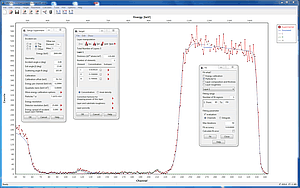INTRODUCTION
SIMNRA is a Microsoft Windows program for the simulation of charged particle energy spectra and gamma-ray yields for ion beam analysis with incident ions from about 100 keV to many MeV.
SIMNRA can be used for the simulation of- Rutherford backscattering spectrometry (RBS),
- elastic backscattering spectrometry with non-Rutherford cross-sections (EBS),
- nuclear reaction analysis (NRA),
- elastic recoil detection analysis (ERDA),
- medium energy ion scattering (MEIS),
- particle induced gamma-ray emission (PIGE),
- neutron-induced elastic recoil detection analysis (n-ERDA),
- neutron-induced nuclear reaction analysis (n-NRA).
Almost 3000 different non-Rutherford, nuclear reactions and PIGE cross-sections for incident protons, deuterons, 3He, 4He and Li-ions are included. SIMNRA can calculate any ion-target combination including incident heavy ions and any geometry including transmission geometry. Arbitrary foils in front of the detector and arbitrary beam windows are possible.

The cross-section calculator SigmaCalc by A. Gurbich allows calculating cross-section data for non-Rutherford backscattering and nuclear reactions for many ion-target combinations at any angle: This allows unsurpassed accuracy for the simulation of a large number of elastic backscattering and nuclear reaction analysis measurements.
For the scattering of identical particles the quantum-mechanical Mott cross-section can be applied using the included MottCalc program by M. Kokkoris.
- Supported methods: RBS, EBS, NRA, ERDA, MEIS, PIGE, n-ERDA, n-NRA
- Fully graphical user interface with support for high-resolution devices and multi-monitor support
- Available stopping powers: SRIM 2003 or higher, Konac et al. (for C and Si targets), Ziegler-Biersack (identical to SRIM 97), Andersen-Ziegler, DPASS, user defined
- Energy loss straggling: Bohr straggling, Chu correction to Bohr straggling, straggling due to charge state fluctuations, propagation of straggling in thick layers
- Geometrical straggling due to finite beam width and detector aperture
- Multiple small angle scattering, identical to E. Szilágyi's DEPTH code
- Plural large angle scattering
- Accurate simulation of narrow resonances in the cross-section
- Surface roughness (rough layers, rough substrate)
- Sample porosity
- Roughness of foils in front of the detector and roughness of beam windows
- Live time correction and pile-up simulation, pile-up correction of experimental data
- Detector types: Solid-state detectors, thin (transmission) detectors, time-of-flight detectors, electrostatic detectors
- Data fitting (layer thicknesses, compositions etc.) by means of the Simplex algorithm
- Data analysis tools: Calculation of scattering kinematics, stopping, peak integrals, positions of elements, ...
- OLE automation for automatic analysis of large numbers of spectra or development of new codes
- Read/write of data files in IBA data format (IDF) for easy exchange of data with other simulation programs
- Smooth integration into the windows environment by thumbnail preview images of data files, display of file properties, and integration into Windows Search
The capabilities of the program are fully described in the SIMNRA User's Guide (378 pages, PDF, 4769 KB).
SIMNRA is not free. It is a shareware program, which can be used for a trial period of 30 days without fee. If you want to use SIMNRA after this period, you have to register. See Registration / Pricing for registration and pricing details.
SIMNRA is used at more than 220 laboratories world wide and referenced in more than 1800 publications (November 2020). It is the most popular program for the evaluation of ion beam analysis data since 2007, see Citations.
![]() Current version:
SIMNRA 7.04.
Current version:
SIMNRA 7.04.
SIMNRA was developed by Matej Mayer at the Max-Planck-Institut für Plasmaphysik, Garching, Germany. More information about the author.
Additional resources
- MultiSIMNRA: This code was developed by Cleber Rodrigues and Tiago Silva from the University of São Paulo, Brazil. It allows self-consistent analysis and fitting of multiple IBA spectra. It can be downloaded freely from the MultiSIMNRA web site.
- SIMTarget: This code was developed by Julien Colaux from the University of Namur, Belgium. It allows a quick generation of the target file used by SIMNRA regardless of the sample complexity. It can be downloaded freely from the SIMTarget website.